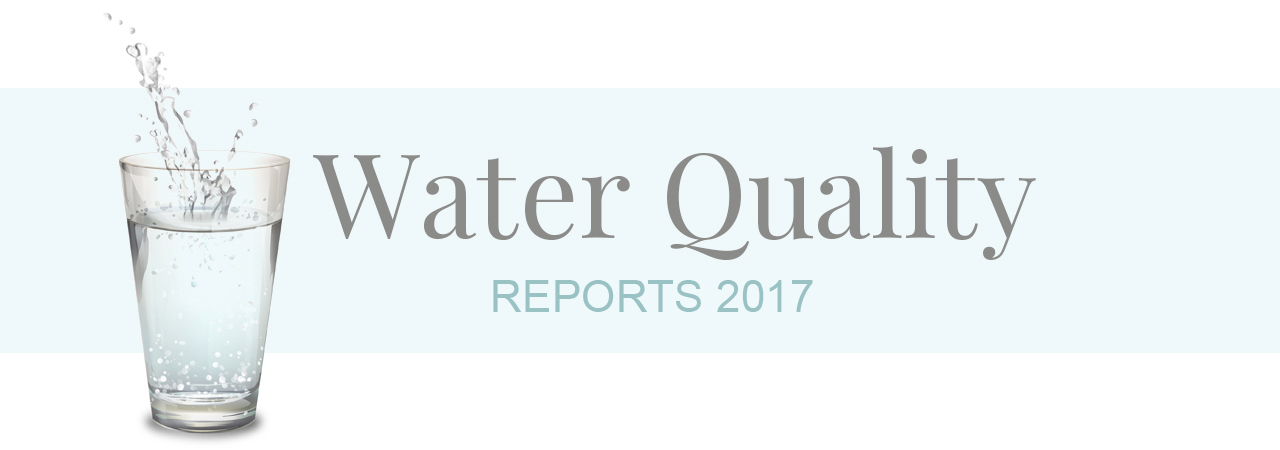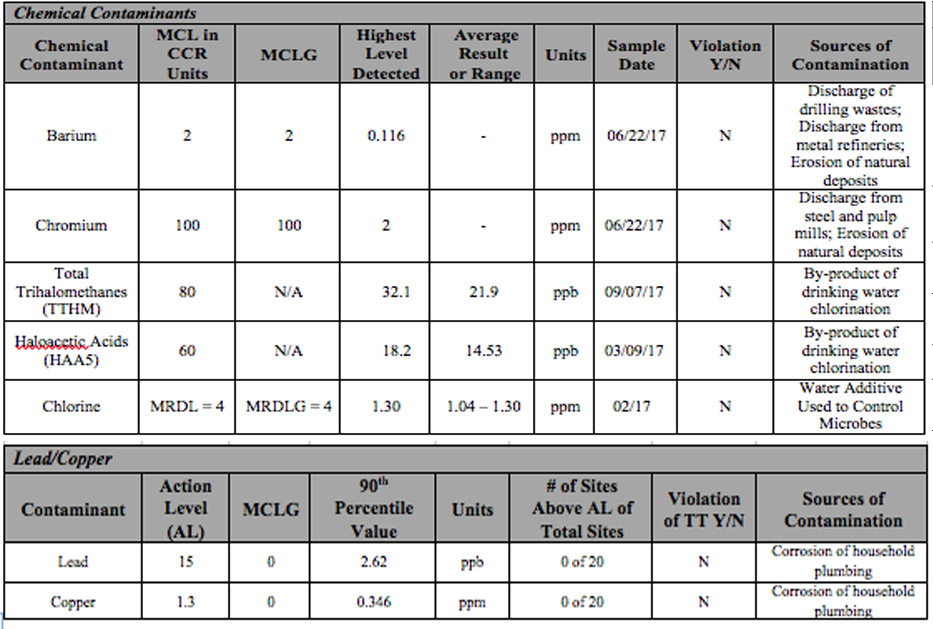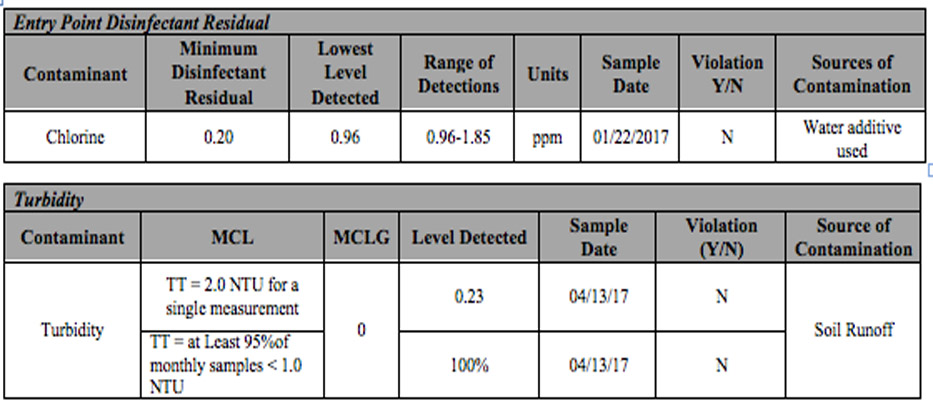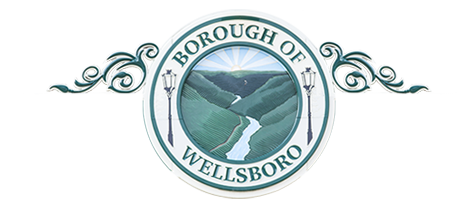
Water Quality Reports
2017 Annual Drinking Water Quality Report
Este informe contiene información importante acerca de su agua potable. Haga que alguien lo traduzca para usted, ó hable con alguien que lo entienda.
We're pleased to present to you this year's Annual Drinking Water Quality Report. This report is designed to inform you about the quality water and services we deliver to you every day. Our constant goal is to provide you with a dependable supply of drinking water. We want you to understand the efforts we make to continually improve the water treatment process and protect our water resources. We are committed to ensuring the quality of your water. Our water source is a combination of well water and surface water sources located in Charleston and Duncan Townships
We have a source water assessment report available from our office that provides more detailed information such as potential sources of contamination. A summary of our water system’s susceptibility to potential sources of contamination follows: A Source Water Assessment of the sources, which supply water to the Wellsboro Filtration Plant, was completed in 2004 by the PA Department of Environmental Protection (PADEP). The Assessment has found that the sources are potentially most susceptible to agricultural activity and roadway spills, deicing materials and on lot septic systems. Overall, our sources have little, risk of significant contamination. Summary reports of the Assessment are available by writing to Jack McKernan, 203 W. Third Street, Suite 101, Williamsport, Pa. 17701. Complete reports were distributed to municipalities, water supplier, local planning agencies and PADEP offices. Copies of the complete report are available for review at the PADEP North Central Regional Office, Records Management Unit at (570) 327-3693.
This report shows our water quality and what it means.
If you have any questions about this report or concerning your water utility, please contact Mark Dieffenbach at the Borough Office, (570) 724-4604. We want our valued customers to be informed about their water utility. If you want to learn more, please attend any of our regularly scheduled meetings. They are held on the 3rd Tuesday each month at 4 pm.
The Wellsboro Municipal Authority routinely monitors for constituents in your drinking water according to Federal and State laws. This table shows the results of our monitoring for the period of January 1st to December 31st, 2017. All drinking water, including bottled drinking water, may be reasonably expected to contain at least small amounts of some constituents. It's important to remember that the presence of these constituents does not necessarily pose a health risk.
Some people may be more vulnerable to contaminants in drinking water than the general population. Immuno-compromised persons such as persons with cancer undergoing chemotherapy, persons who have undergone organ transplants, people with HIV/AIDS or other immune system disorders, some elderly, and infants can be particularly at risk from infections. These people should seek advice about drinking water from their health care providers. EPA/CDC guidelines on appropriate means to lessen the risk of infection by cryptosporidium and other microbiological contaminants are available from the Safe Drinking Water Hotline (800-426-4791).
In the table to follow you will find many terms and abbreviations you might not be familiar with. To help you better understand these terms we've provided the following definitions:
Mrem/year – millirems per year (a measure of radiation absorbed by the body)
ppm – Parts per million or Milligrams per liter (mg/l)
ppq – Parts per quadrillionion or picograms per liter
ppt – Parts per trillion, or nanograms per liter
ppb – Parts per billion or micrograms per liter (ug/l)
pCi/L – Picocuries per liter is a measure of the radioactivity in water.
Action Level (AL) – The concentration of a contaminant which, if exceeded, triggers treatment or other requirements which a water system must follow.
Nephelometric Turbidity Unit (NTU) - Nephelometric turbidity unit is a measure of the clarity of water. Turbidity in excess of 5 NTU is just noticeable to the average person.
Maximum Contaminant Level (MCL) – The highest level of a contaminant that is allowed in drinking water. MCL’s are set as close to the MCLGs as feasible using the best available treatment technology.
Maximum Contaminant Level Goal (MCLG) – The level of a contaminant in drinking water below which there is no known or expected risk to health. MCLGs allow for a margin of safety.
Maximum Residual Disinfectant Level (MRDL) – The highest level of a disinfectant allowed in drinking water. There is convincing evidence that addition of a disinfectant in necessary for control of microbial contaminants.
Maximum Residual Disinfectant Level Goal (MRDLG) – The level of a drinking water disinfectant below which there is no known or expected risk to health. MRDLGs do not reflect the benefits of the use of disinfectants to control microbial contamination.
Minimum Residual Disinfectant Level (MinRDL) – The minimum level of residual disinfectant required at the entry point to the distribution system.
Level 1 Assessment – A level 1 assessment is a study of the water system to identify potential problems and determine (if possible) why total coliform bacteria have been found in our system.
Level 2 Assessment – A level 2 assessment is a very detailed study of the water system to identify potential problems and determine (if possible) why an E. coli MCL violation has occurred and/or why total coliform bacteria have been found in our water system on multiple occasions
Treatment Technique (TT) - A required process intended to reduce the level of a contaminant in drinking water.


We constantly monitor for various constituents in the water supply to meet all regulatory requirements. This past year our CCR report was received by the department before the required deadline. The Radiation monitoring samples checked every 6 years consisting of Combined Uranium, Radium-226, and Radium-228 due in 2017 were missed, which resulted in a monitoring violation for each of these contaminants. As soon as the Authority was made aware of this the samples were collected on 02/27/18 and were all found to be non-detectable levels.
All sources of drinking water are subject to potential contaminants that are naturally occurring or manmade. Those contaminants can be microbes, organic or inorganic chemicals, or radioactive materials. Drinking water, including bottled water, may reasonably be expected to contain at least small amounts of some contaminants. The presence of contaminants does not necessarily indicate that the water poses a health risk. More information about contaminants and potential health effects can be obtained by calling the Environmental Protection Agency’s Safe Drinking Water Hotline at 1-800-426-4791.
The sources of drinking water (both tap water and bottled water) include rivers, lakes, streams, ponds, reservoirs, springs and wells. As water travels over the surface of the land or through the ground, it dissolves naturally-occurring minerals and, in some cases, radioactive material, and can pick up substances resulting from the presence of animals or from human activity.
Contaminants that may be present in source water include:
- Microbial contaminants, such as viruses and bacteria, which may come from sewage treatment plants, septic
systems, agricultural livestock operations, and wildlife.
- Inorganic contaminants, such as salts and metals, which can be naturally-occurring or result from urban
storm water runoff, industrial or domestic wastewater discharges, oil and gas production, mining or farming.
- Pesticides and herbicides, which may come from a variety of sources such as agriculture, urban stormwater
runoff, and residential uses.
- Organic chemical contaminants, including synthetic and volatile organic chemicals, which are byproducts or
industrial process and petroleum production and mining activities.
Information about Lead
If present, elevated levels of lead can cause serious health problems, especially for pregnant women and young children. Lead in drinking water is primarily from materials and components associated with service lines and home plumbing. Wellsboro Municipal Authority is responsible for providing high quality drinking water, but cannot control the variety of materials used in plumbing components. When your water has been sitting for several hours, you can minimize the potential for lead exposure by flushing your tap for 30 seconds to 2 minutes before using water for drinking or cooking. If you are concerned about lead in your water, you may wish to have your water tested. Information on lead in drinking water, testing methods, and steps you can take to minimize exposure is available from the Safe Drinking Water Hotline or at http://www.epa.gov/safewater/lead.
Please call our office if you have questions.

